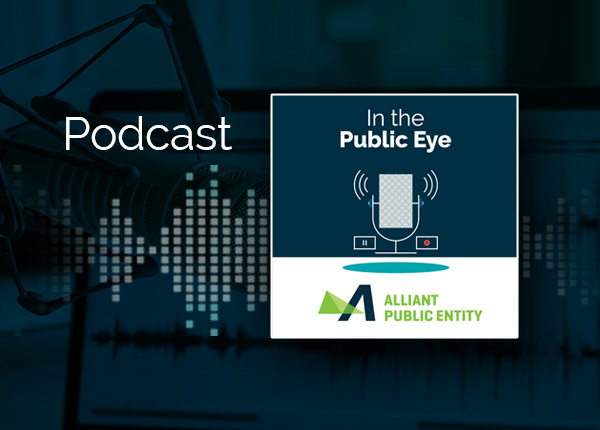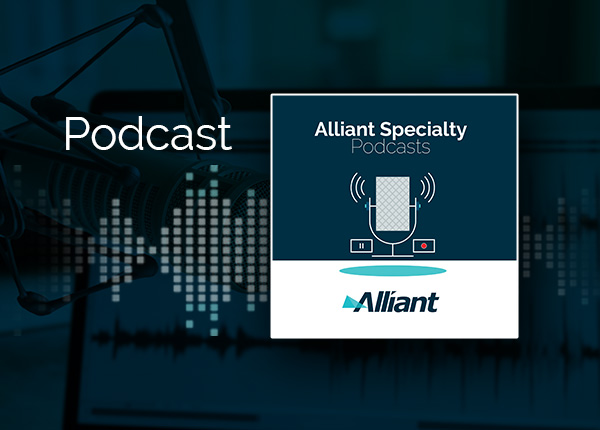
Specialty Podcast: Shielding Lenders from Pollution Risks in Real Estate
By Alliant Specialty
What is the difference between PLL and Lender Environmental Insurance? How can lenders shield themselves from pollution risks in real estate transactions? Bill Nellen and Bill Havard, Alliant Environmental Group, discuss the differences in environmental liability coverages and how these particular policies can help fill crucial gaps in standard coverage and protect against known pollution conditions.
Intro (00:00):
You're listening to the Alliant Specialty Podcast, dedicated to insurance and risk management solutions and trends shaping the market today.
Bill Nellen (00:09):
Welcome back to another Alliant Specialty podcast. I'm Bill Nellen, the leader of Alliant's Environmental Group, and I'm excited to introduce everybody to Bill Havard, who's a Senior Vice President based in Phoenix, who has the specialty, expertise and experience level that we think everybody can benefit from. Our topic, although environmental insurance may seem specialized enough, Bill, you have an expertise in lender pollution liability. Can you tell us a little bit more about what that area is of your specialization and who needs to know more about it?
Bill Havard (00:50):
Sure. So, we generally refer to it as lender environmental insurance. Like the name implies, it's primarily designed to protect a lender's interest in a transaction, and it will protect them for any pollution conditions that can arise either on, coming from or migrating onto the collateral that they're taking for the real estate loan. And it's used by anybody that lands on commercial real estate, whether on a primary senior position, whether they're a mezzanine lender or a secondary lender. So, it can be anybody from a credit union to a large traditional bank, a community bank, a regional bank. The largest buyer of the product that I've found over the last 20 years has been people that originate what is called commercial mortgage-backed securities lenders or CMBS lenders.
Bill Nellen (01:40):
For the broader audience, how would they differentiate this type of product from what we consider a standard site pollution legal liability, a PLL, PPL and EIL, all of which are used for first- and third-party environmental liability exposures, both from preexisting historical and operational new conditions for cleanup, bodily injury, property damage, business interruption, etc.
Bill Havard (02:09):
Sure. So, there's some alignment of interest between the lenders and the coverages they can get on the pollution legal liability forms. So, those PLL forms traditionally have been used by owners, buyer-sellers of commercial real estate, and you can look to add tenants or lenders to those forms. The gap that the lender policy fills is many times there's concerns with the collateral. It might have an ongoing or existing pollution condition or known pollution condition that you really can't get coverage for that known issue on the PLL policies. The lender policies, you're able to fill that gap for the lender, right? So, they're set up to be triggered if there's a monetary default declared on the loan and some sort of actionable pollution condition either on or coming from the collateral. So, you can have a site that has a known condition, an active cleanup that is in some stage that's not going to be addressed until well after the loan is originated. So as long as the structure of the loan and the credit is strong enough from the carrier's perspective, they're willing to take that risk and offer full cover to the lenders without any sort of exclusions that you would find on the PLL policies.
Bill Nellen (03:18):
Are you just covering the liabilities of the lender or are you also covering the borrower and who pays for the insurance typically?
Bill Havard (03:31):
So typically, it just covers the lender, it has to be a lender in some capacity. There are instances where the carriers will consider adding the borrower and they bifurcate the cover, like the borrower's cover will have the exclusions and the lender will have full cover. That's not the normal structure of the transaction though. Typically, it's just the lender covered on these policies. With respect to who's paying for it, that can be the lender directly, it can be the borrower, it can be them sharing the cost. We've had instances where the issue with the collateral is discovered late in the loan origination process, and the lender doesn't want to go back to the borrower, and if there's enough profit in the deal, the lender will just buy the policy for themselves to address the concerns with the lender or with the collateral, and they won't even tell the borrower about it. Since it's a lender policy, the lender's the one that fills out the applications, they're the one that issues the bind order. But we've seen anywhere from the lender paying for it to the borrower, paying for it, to them splitting the cost.
Bill Nellen (04:28):
And what's the marketplace for this? We often talk about the pollution liability insurance marketplace, both for combined general liability pollution, ancillary lines, PLL, CPL, E&O. At somewhere around 3 billion a year in gross written premiums with something north of 30 carriers writing it, I would imagine that this market is a subset of that larger marketplace.
Bill Havard (05:02):
It is. There are four carriers that primarily provide this coverage in the market, just over a hundred million in combined capacity between the four. As far as premium volume on an annual basis, if I had to guess, it's somewhere probably between $15 - $20 million. It's not a huge chunk of that $3 billion you previously referenced.
Bill Nellen (05:22):
And is this a growing market or a shrinking market? I know that in today's lending environment, and hopefully with the news we've recently gotten in the financial press that inflation is easing. Maybe we won't see as many interest rate hikes by the Fed. Hopefully that'll open up some lending capacity in the marketplace. But are there folks that are not as sophisticated about this product offering, that you imagine should be or are overlooked in some way?
Bill Havard (05:58):
I believe so. I think it just hasn't been communicated to the right people at a lot of the lending institutions. So, they just don't know about it, or they have a misconception about what it does and what it does not do and how it's triggered. I do think there's a large upside to this product. How you realize that though, I haven't been able to crack that nut, so to speak.
Bill Nellen (06:18):
Hopefully this helps. I know you're in the marketplace doing this quite a bit. Can you share with us some success stories or recent history that you've had where people can learn from seeing what the application has already been for their real-life exposures?
Bill Havard (06:40):
Sure. So, the three main categories that the lenders we work with utilize this insurance product is, the first one is the obvious one that we talked about previously. It's you have a known issue; you've got some sort of known release or known condition that has to be dealt with and it can't be dealt with before the lender funds the loan. So, in that instance, so here's a case example: We had a $32 million loan on a latex pay manufacturing facility for one of the lenders we work with. It had been in operation for over 50 years, and there were solvents that were noted in the soil and on the collateral. We were able to obtain a policy for the lender that covered them for 13 years. And $3 million limit on that went for roughly $66,000. It's a one-time premium due upfront, good for the entire 13 years. It's not an annual premium. So, that would be an example of a site that had issues and the lender needed get some sort of mechanism to mitigate their concerns with the collateral, and we used the product to do it.
Bill Nellen (07:41):
13 years. That seems longer than the traditional PLL is being offered in the marketplace. Is that a function of the length of the loan and some sort of maturity period?
Bill Havard (07:53):
It is. So typically, most of the lenders we work with, everybody always starts with, "Why can't we have a term exactly equal the maturity date?" So, stepping back from 10,000 feet, the issue with that is that's great and that works if the loan's paid off and there's no issues. But if you have a 10-year balloon loan and there's any issues or hiccup at or near maturity, most of the lenders we work with are not going to declare a default right at the maturity date. They're going to be having conversations with the lender about, "Hey, can we extend the loan? Can we modify it? What can we do?" The option of last resort typically is the declaration of default. So, they're going to be looking for alternate solutions before they actually declare the default. So, when you actually do declare a default, you're well beyond the maturity date, right?
Bill Havard (08:38):
So, if the 10-year loan and you set the policy at 10 years, they're most likely going to declare a default beyond that 10-year window. And most lenders don't want to be rushed to make a decision on how they make themselves whole if a loan goes sideways. So, they want as much time as possible to explore every single recourse they have to make themselves whole. Plus, they have to get access to the collateral. And if they're going to declare default, maybe the relationship with the borrower or the sponsor and the guarantor isn't the best. Maybe they have to go to court to get access to the collateral. Maybe they have to do another phase one, maybe they have to do another phase two site assessment. That all takes time. So, most of the lenders we work with want a three-year tail beyond the maturity date. They feel like that gives them enough time to get access to the collateral, have discussions with the borrower, and evaluate what their best recourse is for making themselves whole. There's no written reason. There's no standard for it. It primarily was used by the CMBS industry, but most of the lenders we work with that don't do CMBS also do a three-year term beyond the maturity date. That's the reasoning behind it.
Bill Nellen (09:46):
What's an example of a known condition?
Bill Havard (09:49):
You've got a retail shopping center who had a dry cleaner there from 1990 to 2015. They've recently conducted sampling at the location in the soil and groundwater. They discovered constituents associated with the dry-cleaning operations in the soil and groundwater that are above an action level that will require cleanup. That would be an example of a known issue. As far as other instances where this is used, we also see lenders use it as a replacement to what's called the warm body carve out and the loan agreement with respect to the environmental indemnity. So, in those instances, you could have an office building that has a clean environmental report or a phase one environmental site assessment that doesn't have any sort of what we call RECs, recognized environmental conditions, or HRECs or CRECs. Otherwise clean, no issues, but the sponsor or guarantor for the loan doesn't want to personally sign the environmental indemnity in the loan agreement. And so, there are lenders that will accept the lender's policy in lieu of that sponsor or guarantor signing the environmental indemnity. So, let's say you have a 10-year loan with an office building clean report, you could secure an environmental policy for the lender somewhere between $25,000 and $30,000 for a $1 million limit and a 13-year term.
Bill Nellen (11:05):
Bill, it sounds like you have a lot of expertise in this area that a lot of others don't, and that you've honed it over many, many, many years. This is an expertise that Alliant is excited about and something that I think people in the marketplace could benefit from. What would you tell them, including how to reach out to you, so you can help?
Bill Havard (11:31):
Well, I'd say if they had any questions, they can absolutely call us or call their Alliant rep, and we can talk about what we would need. We can give them real life feedback because we're in the market every day. It's very easy for us to gather some general information on the phone and give reliable estimates or ballparks to the customers. And then if they want to take it further to proposals, we can do that and we can talk about the necessary information. It's not just the environmental reports. I mean, that's one of the biggest misconceptions. It's an environmental product, so you only need the environmental reports. There's much more that goes to the underwriting and to convincing the underwriters to take the risk than just the environmental reports.
Bill Nellen (12:09):
Well, this has been super helpful to better understanding this area of your expertise and further adding to the Alliant Environmental Group and Alliant Specialty P&C, all around. Thank you for taking the time and thank you all for listening and participating.
Bill Havard (12:25):
Thank you.
Alliant note and disclaimer: This document is designed to provide general information and guidance. Please note that prior to implementation your legal counsel should review all details or policy information. Alliant Insurance Services does not provide legal advice or legal opinions. If a legal opinion is needed, please seek the services of your own legal advisor or ask Alliant Insurance Services for a referral. This document is provided on an “as is” basis without any warranty of any kind. Alliant Insurance Services disclaims any liability for any loss or damage from reliance on this document.
Thanks for your message.
We’ll be in touch shortly.



